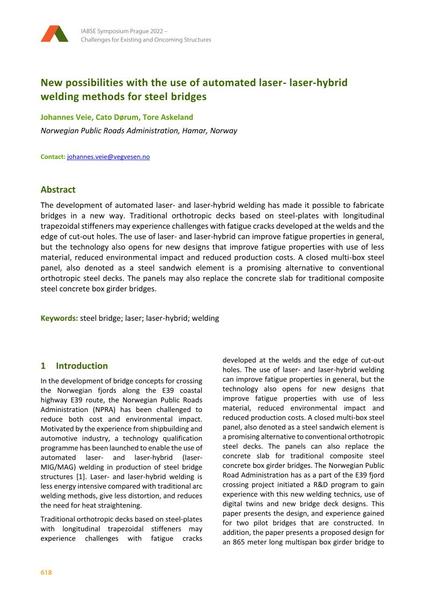New possibilities with the use of automated laser- laser-hybrid welding methods for steel bridges

|
|
|||||||||||
Bibliographic Details
| Author(s): |
Johannes Veie
(Norwegian Public Roads Administration, Hamar, Norway)
Cato Dørum (Norwegian Public Roads Administration, Hamar, Norway) Tore Askeland (Norwegian Public Roads Administration, Hamar, Norway) |
||||
|---|---|---|---|---|---|
| Medium: | conference paper | ||||
| Language(s): | English | ||||
| Conference: | IABSE Symposium: Challenges for Existing and Oncoming Structures, Prague, Czech Republic, 25-27 May 2022 | ||||
| Published in: | IABSE Symposium Prague 2022 | ||||
|
|||||
| Page(s): | 618-623 | ||||
| Total no. of pages: | 6 | ||||
| DOI: | 10.2749/prague.2022.0618 | ||||
| Abstract: |
The development of automated laser- and laser-hybrid welding has made it possible to fabricate bridges in a new way. Traditional orthotropic decks based on steel-plates with longitudinal trapezoidal stiffeners may experience challenges with fatigue cracks developed at the welds and the edge of cut-out holes. The use of laser- and laser-hybrid can improve fatigue properties in general, but the technology also opens for new designs that improve fatigue properties with use of less material, reduced environmental impact and reduced production costs. A closed multi-box steel panel, also denoted as a steel sandwich element is a promising alternative to conventional orthotropic steel decks. The panels may also replace the concrete slab for traditional composite steel concrete box girder bridges. |
||||
| Keywords: |
welding steel bridge laser laser-hybrid
|
||||
| Copyright: | © 2022 International Association for Bridge and Structural Engineering (IABSE) | ||||
| License: | This creative work is copyrighted material and may not be used without explicit approval by the author and/or copyright owner. |
||||
